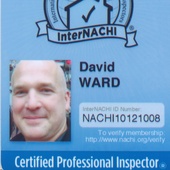Last year I saw an amazing number of new high efficiency furnaces being installed in homes due to the U.S. Government energy tax rebates of up to $1500. Although this was a good thing, many homeowners chose not to upgrade their water heaters to high efficiency direct venting units. This in turn has caused a large number of "Orphaned Water Heaters", meaning that water heater vents into the chimney alone.
Back in the day, homes were designed with chimneys to vent both the furnace and water heater. The coal and oil fired furnaces provided plenty of heat needed to create positive pressure inside the chimney which allowed the byproducts of combustion (carbon monoxide and water vapor) to safely draft up and out the chimney. Even when natural gas came along there was still enough heat being expelled to allow positive pressure.
When high efficiency furnaces (90% and above) arrived they no longer needed to be vented out of the chimney and use PVC pipe to vent to the outside. By removing the furnace from the chimney it is now over sized to vent the water heater. Heavier cold air will settle down inside and since a water heater does not run nearly as much as a furnace, the chimney cools rapidly. The water heater now vents into a cold chimney which causes condensation on the inside from the water vapor produced by combustion. It can literally be"raining" inside the chimney now. This excessive moisture can cause mortar to fail, spalling of bricks, plaster degradation, paint bubbles, and mold/mildew problems. Another issue is safety. There also may not be enough positive draft pressure to expel all of the carbon monoxide gas produced by combustion which could spill back into the house. This situation is worsened when you create negative pressure conditions inside the house by running bath and kitchen vent fans and your clothes dryer.
As part of my inspections I always test for carbon monoxide in the house, but if there is an orphaned water heater I strongly recommend having a "worst case scenario" combustion analysis be done to ensure that there is no carbon monoxide spilling back into the house even if the worst possible conditions occur. This test is performed by running your combustion appliances and by turning on all exhaust fans, dryer and furnace air handler to make sure that your combustion appliances do not back draft from the negative air pressure these devices are causing.
If this test fails, you should either have a properly sized stainless steel chimney liner installed for the existing water heater or upgrade to a new direct venting unit (PVC vent pipe to outside).
Here are some of my inspection photos showing a perfect example of this problem.
Typical Orphaned water heater - The mortar around the connection into the chimney had an extremely high moisture reading of 27% from the buildup of condensation due to insufficient draft.
The condensation buildup was causing moisture to permeate the chimney mortar and seep down the wall allowing mold and mildew to grow.
The increased condensation inside the chimney has caused the mortar to deteriorate resulting in loose brickwork.
The moisture trapped inside the brick has caused the brick face to split (spall) due to the pressure exerted during the freeze thaw cycle.
The condensation caused by the orphaned water heater has also deteriorated the firebox and rusted out the damper making the fireplace unsafe to use.
My testing found the carbon monoxide level and draft pressure were just at the threshold of failing, so the owner decided to have a new stainless steel chimney liner installed as the water heater was not that old and in excellent condition. They also need extensive work on the chimney to repair the moisture damage caused by this situation.
If you have a home with an orphaned water heater be sure to have it tested today, as it could save you a lot of money in the long run as well as ensure that your home is safe from possible carbon monoxide exposure.
I am certified by the Building Performance Institute (BPI) to perform this testing.
Give me a call today if you have questions (773) 559-3360

Comments(9)